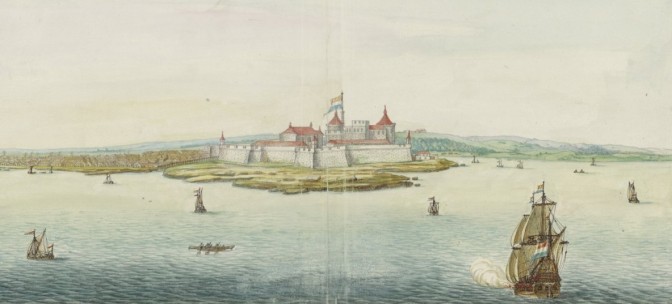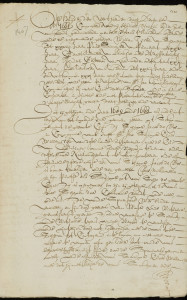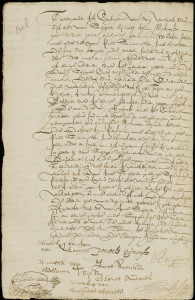While searching the notarial archives at the Amsterdam City Archives, I came across a record that tells how Dutch merchants took African slaves from Guinea and shipped them to the New World, trading some in the West Indies and taking the rest to New Netherland. As it is rare to find accounts of voyages of slave vessels, I thought I would share this document with you.
Translated abstract
14 December 1661
Willem Tijssen of Schermerhorn, age 28, Paul Simonssen of Purmerend, 25, Gerret Andriessen of Blokzijl, age 25, Reijndert Gerrittssen of Leeuwarden, age about 22, Jacob Arentssen of Amsterdam, age 24 and Jan van Kampen, age 26, all sailors and now being in Amsterdam.
They declare at the request of Jan Kaspar Hattingh, merchant in Amsterdam, that they sailed in 1659, 1660 and the beginning of 1661 on the ship called “de Geboorte Christy” [The Birth of Christ], with skipper Jacob de Vos, accompanied by the vessel “St. Jan” [Saint John], with skipper Claes Willemsem.
They went to the coast of Guinea to take in negroes to transport those to New Netherland. During the voyage skipper Jacob de Vos died and said Claes Willemsen became skipper in his place.
Because of contrary winds, they landed at the Spanish West Indies, where they were forced to seek refreshments because of lack of water and victuals. They landed in Cartagena where they traded some negroes for supplies. The boat that was out to take in supplies was taken by the Spanish.
At Cartagena, the skipper transferred 10 sailors from the ship to prison, including said Paul Simonssen, Jacob Arentssen and Jan van Kampen, for reasons unknown to these men. Skipper Claes Willemsen was usually drunk. The skipper falsely accused them before the governor of having wanted to cut his throat. There was no truth to these accusations, since they always served him as honest sailors. Since they saw no other means to get out of prison, at that time they declared after severe threats by the governor, and payment of their monthly wages and a little above, that the said two ships traded negroes for victuals in several Spanish places.
They declare that they only gave that deposition out of necessity. They never knew the ships to intend to trade in the Spanish West Indies.
This deposition, taken at the request of the merchant, was probably meant to account for his presence in the West Indies at a time when there was a trade embargo against Spain.

Fortress of Elmina, coast of Guinea. Johannes Vingboons, circa 1665. Image credits: Nationaal Archief
A chilling account of the Dutch role in the slave trade
Disclaimer
In this article, I translated the terms as used in the document. These terms can be offensive today, but reflect the viewpoints of that period. By staying true to the original documents, I hope to give some more insights into this sad part of our history.
Source
- Public notary Hendrick Venkel, minutes 2 January 1660 – 31 December 1660, call number 3015, p. 1407-1408, deposition by Willem Tijssen, Paul Simonssen, Gerret Andriessen, Reijndert Gerritssen, Jacob Arentssen and Jan van Kampen, 14 December 1661; “5075: Archief van de Notarissen ter Standplaats Amsterdam” [5075: Archive of Notaries Residing in Amsterdam], finding aid with scans, Stadsarchief Amsterdam [Amsterdam City Archives] (http://stadsarchief.amsterdam.nl/archieven/archiefbank/inventaris/5075.nl.html : accessed 11 July 2014)




With rumors in the family about slave shipping traders on my grandmother’s maternal side and an X chromosome bearing some African DNA, would it be logical to assume that I might have an African ancestor through my Dutch ancestors?
I should mention I match my Dutch 3rd cousins on their X chromosome, so I assume that my X chromosome is my Dutch grandmothers.
Your X-chromosome can change whenever a mother passes it on, by a process called crossover. Also, if you are female, you have two X-chromosomes so your cousins matching you does not mean they match you on that African segment.
That is impossible to say without studying your DNA results and documented tree. There were some Africans in the Netherlands, as household servants. There were Africans in the Dutch colonies, brought there as slaves. But without knowing where the rest of your ancestors were, I cannot predict where your African DNA came from. Also, depending on the size of the segment and the algorithm that detected it, it could be noise.
Hello,
I have a Freed Slave Archive for my GG Grandfather, is it possible you can help me understand this document more?
One of my ancestors worked for the Dutch West Indian Co. in Aruba in the mid 1600s. His daughter accompanied him and then they parted company in New York when she married someone she met on the boat. Her father was travelling from New York to go back to Friesland when the ship was lost. Do you think you could help me find out where he came from etc. His daughter was Aeltje Jans. She later married my fraternal ancestor who was Pierre Mabille aka van Norden who arrived in New York in 1623.
Hi Kelly,
Aeltje Jans is a very common name. I would have to analyze what else is known about her and her father. Unfortunately, the West India Company records were sold for scrap paper in the 1800s so there are few records left. Could you please contact me with the details of what you know so I can give you a proposal?
My Dutch ancestry goes back to the Albany, NY area where they settlled in the first few decades of the 17th century, and from where they emigrated to Canada post-revolutionary war as Loyalists. I found one ancestor born in 1690 who was alleged to have been one half Mahican or Mohawk and the other African. Me and my sister recently did the 23andme test and we both received .2% Congolese. Interestingly no Native American results showed up.